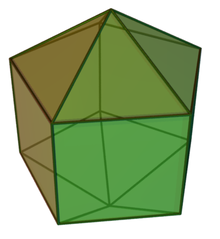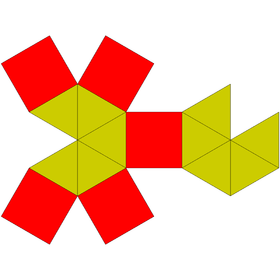Elongated pentagonal bipyramid
| Elongated pentagonal bipyramid | |
|---|---|
 |
|
| Type |
Johnson J15 - J16 - J17 |
| Faces | 10 triangles 5 squares |
| Edges | 25 |
| Vertices | 12 |
| Vertex configuration | 10(32.42) 2(35) |
| Symmetry group | D5h, [5,2], (*522) |
| Rotation group | D5, [5,2]+, (522) |
| Dual polyhedron | Pentagonal bifrustum |
| Properties | convex |
| Net | |
 |
|
In geometry, the elongated pentagonal bipyramid is one of the Johnson solids (J16). As the name suggests, it can be constructed by elongating a pentagonal bipyramid (J13) by inserting a pentagonal prism between its congruent halves.
A Johnson solid is one of 92 strictly convex polyhedra that have regular faces but are not uniform (that is, they are not Platonic solids, Archimedean solids, prisms or antiprisms). They were named by Norman Johnson, who first listed these polyhedra in 1966.
The dual of the elongated square bipyramid is a pentagonal bifrustum.
...
Wikipedia
